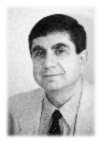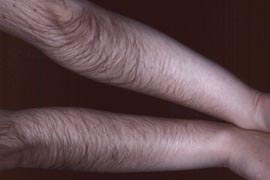 |
Harvey H. Jay, M.D.
|
Harvey H. Jay, M.D.
45 East 62nd. St., New York, NY 10065
Tel: 212-755-2237 * Fax: 212-755-3359


The Scarsdale Inquirer
Health & Fitness
A special section to the Scarsdale Inquirer
A Guide to Laser or Pulsed-Light Hair Removal
By Harvey H. Jay M.D.
Removing hair by shining a light is an elegant concept. Treating hundreds of hairs instantly with a flash of light sounds great. No needles. No anesthesia. No pain medication. Minimal side effects. But, is it true? Does it work? Is it safe? Will it last? Should I try it? Which method is best? What's the difference between lasers and pulsed-light systems?
I have been researching pulsed light hair removal since 1996, and I have heard and seen many innacurate claims from manufacturers, physicians, aestheticians, etc. Here, I will give you what I consider an informed opinion on how to utilize this exicting technology. First of all, make certain that an experienced physician administers or at least is present to supervise your treatment. Proper use of a pulsed-light or laser system requires a knowledge of light, skin and medicine that will optimize results and minimize side effects.
Qualified, experienced physician
If a non physician is operating your system, you are probably being treated with a less sophisticated machine, or at beginner presets on the more advanced systems. In the case of any unusual response, such as swelling, redness, or irritation, you want an experienced dermatologist present to evaluate your response and either modify the machine settings or prescribe medication, usually topical, that can dramatically reduce the likelihood of developing side effects.
You can find a qualified physician by making certain that he or she is board certified, preferably in dermatology, on staff at a reputable medical center, and has considerable experience using the machine with which you are being treated.
This last point can be evaluated by asking to see photographs of patients before treatment and at least six months after, and by getting an estimate of the number of patients the physician has treated successfully.
Numerous systems
Softlight TM hair removal has been widely publicized. Unfortunately, a study published in the Archives of Dermatology reported that all of the hair grew back six months after a single SoftlighTM treatment that involved waxing, tar solution application, and then use of the Nd: YAG laser. Waxing alone was as effective. The SoftlightTM process has been modified, but there is no published data to indicate any better six-month response--even with the modification.
Another treatment option--ruby, alexandrite, or the 800 nanometer diode lasers -- produces similar wavelengths of light. Data published indicates a significant 20-to-63-percent incidence of side effects from ruby laser treatment. These side effects include lightening or darkening of the skin , crusts, scabs, blisters, or scars. These machines are used to treat black or brown hairs on primarily lighter skin colors and not brown or black skin because of the even higher rates of side effects treating darker skin colors. These side effects are usually temporary, but permanent changes may occur.


The dramatic result of a properly administered hair removal treatment is evident in these before and after shots of a womans arms. Removal of unwanted hair on the face, chest and other parts of the body can greatly enhance a patients self confidence and often will have positive effects on personality.
Success with EpiLight
I have treated scores of patients for excess hair with EpiLight pulsed light and have observed up to 80 percent hair removal lasting at least six and up to 13 months after a course of two treatments. I have patients whose hair has not grown back in two or more years. I have treated all skin colors with rare and minimal side effects with this procedure.
EpiLight has thousands of settings and delivers hundreds of wavelengths of light, which allows a qualified physician to customize treatment to the skin and hair colors of each patient. This flexibility minimizes side effects and maximizes hair reduction. EpiLight hair removal is performed without any anesthesia. The only discomfort resembles a quick rubberband snap. Most patients report that is much less painful than lasers, electrolysis, waxing, or over-the-counter devices, which patients report have no long-term effect.
Use of the term permanent is contraversial. Permanent to most people means forever. This is not the case with hair removal. One ruby laser manufacturer recently obtained FDA permission to say permanent, meaning that hair removal lasted for approximately two years. The information is based on the duration of hair follicle resting and growing cycles, but the length of these cycles can vary in different body locations on the same person and at different seasons of the year.
Whar appears to happen, at least with pulsed light or ruby laser treatment, is that terminal or regular hairs that are converted to vellus or miniature hairs. Areas of the body covered by vellus hairs appears hairless or only finely haired, and are therefore more cosmetically acceptable.
Capsule summary
In summary, there are many claims regarding hair removal by pulsed light or lasers. Medical literature shows that SoftlightTM hair removal lasts for fewer than six months. The literature shows also that ruby lasers can produce a two-year reduction of hair but produce a relatively high rate of side efects, even when used in very small test areas in preselected light-skinned patients. Alexandrite and 800 nanometer diode lasers are relatively new, but should produce results similar to ruby lasers.
EpiLight pulsed light in the hands of an experienced physician, who can master its potential for customized treatments, is a safe, comfortable, long term, and rapid method removing black, brown, red, and blond hairs in patients of all skin colors.
Whatever system you choose, make sure you do your homework and find and find a qualified physician whose experience, equipment, and ability justify your trust. Then the chances are very good that your experience will be a a positive one.
For more information and a personal response to your questions, you can access my Web site: www.mdlaserderm.com
Dr. Jay, with a private practice in New York City, is a board-certified dermatologist and clinical assistant professor of dermatology at Cornell Medical Center. He has instructed physicians from around the world in pulsed-light technology.
[The Scarsdale Inquirer] [CBS Internet Minute] [Newsday]
[THE LANCET] [Health Wise] [Vogue] [Men's Journal]
[Home]
Questions? Comments? Please contact us.
Home - FAQ - Before and After Photos - Skin and Treatment Information - In the News - About Dr. Jay - Contact Us - Site Map
Copyright © Harvey H. Jay, M.D. 1996 - 2011. All Rights Reserved.